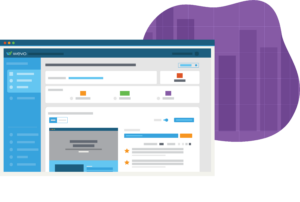Leveraging Insights as a Service to generate deep customer insights, fast.
This article was originally published on Quirks.com. Read it here.
“Artificial intelligence” is a phrase that can take our minds in many different directions.
Not everyone is excited about the role of AI. In fact, 72% of Americans are worried about a future in which robots and computers can complete traditionally human jobs, according to data from Pew Research Center. Most of us have seen movies like iRobot, and we don’t want to suffer a similar fate.
We need to reframe our thinking toward artificial intelligence and how it can help ignite a positive change in the UX research community. Instead of “humans vs. AI,” we need to adopt a “humans, with the help of AI” mind-set. In a study involving 1,500 companies, Harvard Business Review found that companies that have humans and machines working together achieve the most significant performance improvements.
Synergy, not separation, is the key to success.
UX research is inarguably valuable. It’s also costly and time-consuming for research professionals. In our current state, there are two challenges to meet a surging demand for insights:
- Access to the right tools for pro-level UX researchers.
- Insufficient supply of UX researchers available for hire.
Human-augmented AI allows user researchers to generate and analyze tests effortlessly with insights as a service (IaaS) solutions that take minutes to start, run and review.
Combining the brilliance of human UX researchers with the power of AI will spur rapid, accurate insights at scale. This research will be measurable, benchmarked and easily accessible for all parts of your organization.
Demand for Insights is Increasing, and Fast
We’re experiencing an exponential growth in demand for insights. Organizations are feeling the pressure. In order for businesses to accommodate their needs and the needs of their consumers, we’ll collectively need 100 million research professionals by 2050, according to research from the Nielsen Norman Group. Talented researchers don’t grow on trees, so meeting this number may prove difficult. But what’s fueling this explosion of demand for UX research in 2021 and beyond?
Brian Cahak, managing director of digital growth and marketing operations at Accenture Interactive, has a theory. “2021 is the Era of Agility, where the winning businesses will be the ones that identify and respond to consumer needs more quickly than their peer set,” Cahak says.
Most organizations are undergoing a digital transformation, whether it’s intentional or spurred on by the effects of the COVID-19 pandemic. Consumer expectations changed during the pandemic, with an increased desire for flexibility. Roughly 90% of consumers demand more authentic and purposeful experiences with companies, per Accenture. To respond to this shifting market, 74% of companies are trying to be more agile and resilient.
To both be agile and deliver these personalized experiences, brands need to understand their consumers’ emotions and preferences at scale. This means organizations need scalable and reliable tools at their disposal.
The current state of UX research
Researchers have the power to address problems and deliver insights for the entire organization. Organizations need to do everything in their power to fully unlock the potential of their savvy researchers. Only when you combine researcher expertise with new IaaS solutions can you truly be a next-gen research organization.
You might have a small team leading A/B testing and user research. Quantitative and qualitative research might be gathered separately, generated from “rearview mirror data” (like actual usage or behavior) or large-scale quantitative surveys. Commonly, UX research is siloed and researchers aren’t empowered to connect and share their insights with the entire organization.
Many companies are building toward a next-gen research approach but there’s another level to unlock that represents the future of insight-led organizations. It’s possible for a vision of UX to permeate the organization, which empowers broad teams to solve more complex problems.
What’s missing in the current state?
Current research methods aren’t fully meeting the demand for quality, high-volume user feedback. We’re often stuck with pure-play qualitative research that isn’t at volume and pure-play quantitative research that doesn’t clearly address the “why” of the user experience.
Perhaps most importantly, many organizations lack a means of measuring and benchmarking their research against their own results, as well as the competitor landscape. As the great management consultant Peter Drucker once said: “If you can’t measure it, you can’t improve it.”
Artificial intelligence speeds up UX research
Artificial intelligence will never replace human researchers. There’s always going to be a massive need for expert analysis and a researcher-led effort to communicate results into actionable insights for the rest of the organization. As Harvard Business Review found, next-gen organizations will strike the right synergy between humans and machine learning. AI becomes a tool that enables researchers to shine.
Traditional user research requires researchers to manually execute all steps in the process: preparing research plans, recruiting panels, moderating interviews, reviewing hours of video and hundreds of pages of quotes, and manually categorizing the data into useful insights. That could mean months of a researcher’s time tied to a survey of a half-dozen participants.
AI, meanwhile, streamlines certain parts of the research process to produce more rapid research. Artificial intelligence through an IaaS platform can play an integral role in provisioning the panel, scoring users’ experience and pointing researchers towards reliable trends and signals within the research. Researchers can thus spend more time identifying the test, reviewing the results and sharing their findings with their organization, without silos.
It’s also important to note that “artificial intelligence” isn’t a catch-all term. It’s not enough to just leverage any AI; you have to find AI that encompasses a standardized methodology, simple intake and consistent data storytelling. These attributes help your colleagues understand and analyze high-volume user feedback more rapidly and effortlessly.
Insights as a service: Humans, AI and the future
Organizations can turn to an IaaS platform to power their human-augmented AI operations. The combination of smart humans and AI form the foundation of next-gen research. Brands can gain a singular lens to view their brand’s tonality and content, as well as their consumers’ emotions and expectations.
Phillip Quintero, director of design strategy and research at Bright Health, is one insights leader who has leveraged human-augmented AI solutions to achieve outstanding customer research results. “Human-augmented AI blends some of the strengths of other tools into something unique,” Quintero says. “Your data comes back structured, easy-to-understand, sharable and it has both the high sample size you get from surveys and the rich qualitative feedback you get from usability tests.”
All the while, researchers save time for their most valuable activities, with AI helping to score and benchmark large-scale qualitative insights. IaaS solutions can benchmark data against all data points, not just those that exist within the organization. Standardized tests and measurements allow user tests to be compared against other tested experience in your industry.
AI will change the speed and volume of user research. Machines can help researchers achieve results faster and more accurately, at a scale that has previously not been achievable. That leaves researchers to focus on testing and analyzing high volumes of qualitative data, making it possible to feel confident about understanding the “why” in the user insights at scale.
Instead of relying on six to eight users to help us understand how customers think, human-augmented AI as part of an IaaS platform gives researchers qualitative insight from hundreds of users. Organizations can move from more functional and anecdotal findings to emotion-driven findings at scale.
The value of next-gen research in your organization
What does the future of your organization look like once you’ve been able to integrate smart humans and artificial intelligence into your UX research foundation?
Next-gen research organizations are powered by a hunger for improved UX that’s threaded through the entire organization. Robust tools for testing and validation research, including a human-augmented AI-powered IaaS engine, form a standardized tool stack. Qualitative and quantitative insights are required for every UX action. Silos are no more, with teams across the organization leveraging select research techniques. UX researchers can focus their valuable time and energy on solving more complex problems.
So, artificial intelligence isn’t so scary after all, is it? Truthfully, organizations that don’t look for transformative tools to supplement their researchers actually face a scarier reality than those that ignore emerging technologies.
Achieving accurate, rapid UX research results that are scored and benchmarked is within every organization’s reach. Human-augmented AI is a research strategy that can unlock the potential of researchers and lead organizations into the next generation of UX research.
About WEVO
WEVO is a next-gen user experience platform that enables teams to effortlessly uncover customer insights. Leveraging high-volume user feedback and AI, WEVO delivers meaningful insights, enabling user research, product and marketing teams to create the right customer experiences, faster.



